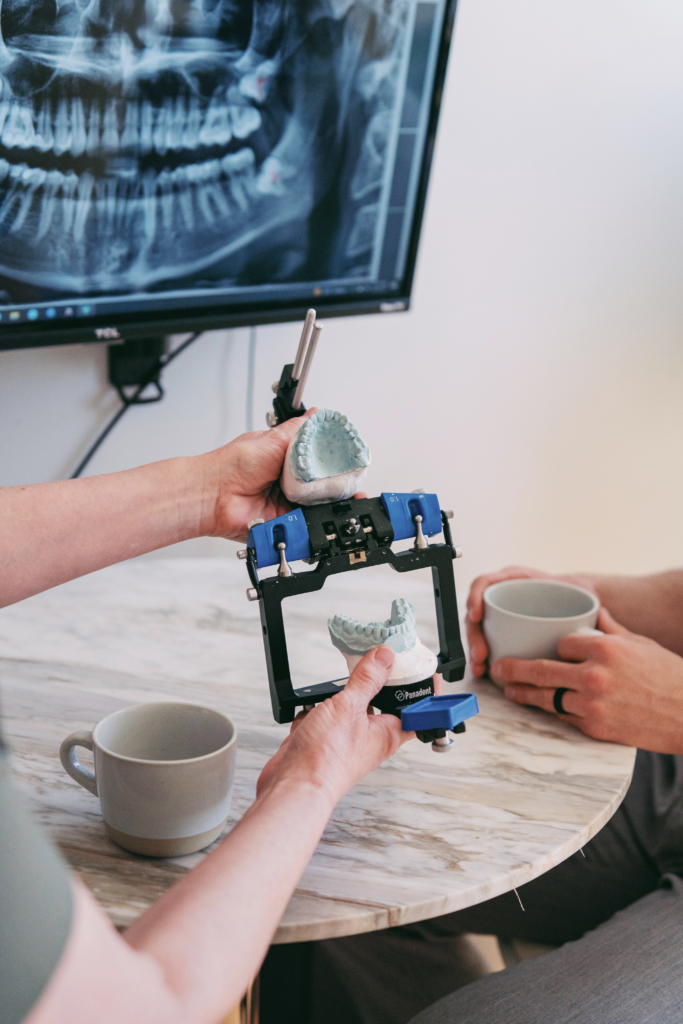Table Of Contents
Understanding Bioesthetic Dentistry
Principles Of Bioesthetic Dentistry
Benefits Of Bioesthetic Dentistry
The Bioesthetic Dentistry Process
The Future Of Bioesthetic Dentistry
Introduction
In pursuit of a radiant smile, optimal oral health, and symptom relief, many individuals seek out various dental treatments and procedures for TMJ. While traditional dentistry often focuses solely on symptom alleviation with bite splints, a revolutionary approach known as Bioesthetic Dentistry aims to achieve a harmonious balance between function & aesthetics by addressing the root cause of TMJ. In this blog, we will explore the principles and benefits of Bioesthetic Dentistry and how it is transforming the way we approach TMJ.
Understanding Bioesthetic Dentistry
Bioesthetic Dentistry is a philosophy and methodology that focuses on restoring an optimal state of equilibrium, comfort, and function within the teeth, jaw joints, nerves, muscles, lips, tongue, mouth, and face. Developed by Dr. Robert L. Lee, this approach relies on natural dental system biology as the guide for restoring beauty and harmony. Predictable and long-lasting results help to ensure the integrity of the joints and teeth, while preventing future degradation.

Principles of Bioesthetic Dentistry
Aesthetics: Bioesthetic Dentistry recognizes the close relationship between oral health and aesthetics. The goal is to achieve a beautiful smile that complements the individual’s facial features, enhancing both appearance and self-confidence.
Balance and Alignment: Bioesthetic Dentists consider the way the teeth, jaw joints, and muscles work together to create a balanced bite/occlusion (the way the upper and lower teeth come together). By restoring proper alignment, this approach aims to reduce strain on the jaw and improve overall function.
Preservation of Tooth Structure: Unlike traditional dentistry that may involve aggressive drilling and removal of tooth structure, Bioesthetic Dentistry focuses on preserving as much natural tooth structure as possible. This helps avoid unnecessary trauma to the teeth.
Joint Health: Bioesthetic Dentists evaluate and address any issues related to the temporomandibular joints (TMJs), ensuring proper function and minimizing discomfort associated with TMJ disorders.
Comprehensive Approach: Instead of addressing one problem at a time, Bioesthetic Dentistry considers the mouth as a whole, looking for underlying causes and offering a holistic solution.
Benefits of Bioesthetic Dentistry
Enhanced Oral Health: By promoting a balanced bite and jaw alignment, Bioesthetic Dentistry helps prevent issues like tooth wear, jaw pain, headaches, and gum problems.
Improved Function: With the emphasis on proper joint function and muscle coordination, patients often experience better jaw mobility. This can translate into reduced discomfort when eating or speaking, improved digestion, and a calmer nervous system (ex. decreases in anxiety).
Natural Aesthetics: Bioesthetic Dentistry takes into account the patient’s facial structure, resulting in dental restorations that blend seamlessly with their natural teeth, creating a more authentic and attractive smile. Oftentimes, a reduction in facial tension (particularly surrounding the eyes, smile, and neck) can be observed as well.
Long-term Solutions: By preserving natural tooth structure and addressing underlying causes, Bioesthetic Dentistry offers durable and sustainable results, decreasing the need for extensive future treatments.
Overall Well-being: Achieving a harmonious oral system contributes to the overall well-being of individuals. Reduced jaw pain and a confident smile can positively impact one’s quality of life in endless ways.

The Bioesthetic Dentistry Process
Comprehensive Examination: The journey to achieving a harmonious smile begins with a comprehensive examination conducted by a qualified Bioesthetic Dentist. During this evaluation, the dentist will assess the patient’s dental history, oral health, occlusion, TMJ function, and facial aesthetics.
Diagnostic Tools: Bioesthetic Dentists may employ various diagnostic tools, such as X-rays, 3D imaging, digital scans, symptom recording, and bite analysis, to gain a detailed understanding of the patient’s oral health and function.
Treatment Planning: Based on the examination and diagnostic findings, the Bioesthetic Dentist develops a personalized treatment plan tailored to the patient’s unique needs and goals. The plan may include restorative procedures, occlusal adjustments, and other treatments to achieve balance and aesthetics.
Restorative Process: Bioesthetic Dentistry uses a minimally invasive technique to allow the jaw joints to relax into their natural state. Once stabilization occurs, form is built upon the natural tooth to bring the jaw and bite into harmony. This process uses biocompatible materials to offer restored vitality that is long-lasting.
Final Results: Once equilibrium is restored, patients often experience relief from TMJ symptoms, increased lymphatic flow, more efficient detoxing, and improved systemic wellness.
The Future of Bioesthetic Dentistry
Bioesthetic Dentistry continues to gain recognition and acceptance within the dental community as a patient-centered and comprehensive approach to treating TMJ. As technology advances, the patient experience will be enhanced with digital integration.
Final Thoughts
Bioesthetic Dentistry represents a significant advancement in the field of dentistry, prioritizing the balance between jaw joint function, aesthetics, and overall health. With its focus on resolving the root cause of dysfunction, this method transforms the traditional approach to treating TMJ.
If you are suffering from TMJ and would like an option that is both in alignment with the principles of biological/holistic dentistry and looks naturally beautiful, consider exploring the world of Bioesthetic Dentistry. With the help of a qualified Bioesthetic dentist, you can achieve a healthier, more radiant smile that truly stands the test of time.

